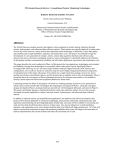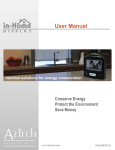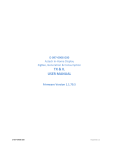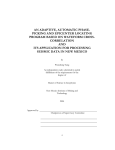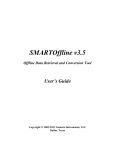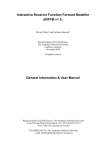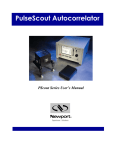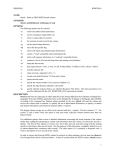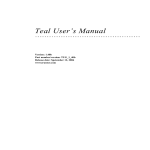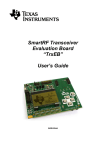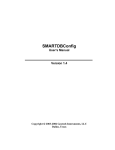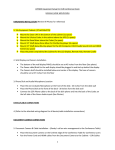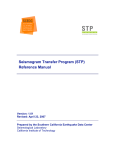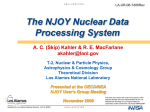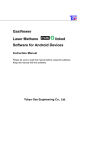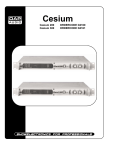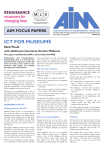Download The 2005 MatSeis and NNSA Seismic Regional Analysis Tools
Transcript
27th Seismic Research Review: Ground-Based Nuclear Explosion Monitoring Technologies THE 2005 MATSEIS AND NNSA SEISMIC REGIONAL ANALYSIS TOOLS Darren M. Hart, B. John Merchant, J. Mark Harris, and Christopher J. Young Sandia National Laboratories Sponsored by National Nuclear Security Administration Office of Nonproliferation Research and Engineering Office of Defense Nuclear Nonproliferation Contract No. DE-AC04-94AL85000 ABSTRACT In continuing to support the National Nuclear Security Administration (NNSA) Knowledge Base (KB), we developed a set of prototype seismic regional analysis tools (MatSeis, EventID Tool, CodaMag Tool, PhaseMatch Tool, and Infra Tool) to facilitate evaluation of new KB data products, and we continue to maintain and improve these tools. A brief description of the latest versions of MatSeis and the regional analysis tools are given below. MatSeis has been extended to use the FISSURES data handling interface (DHI) client FISSURES-Matlab-Interface (FMI) to connect to both the Northern and Southern California data centers located at Berkeley and Caltech, respectively. A routine was built to support instrument response file download and to automatically perform waveform conversion from counts to nanometers. In addition, both SENSOR and INSTRUMENT flatfile database tables are now exportable through the “waveform write” function. For PhaseMatch Tool, a new method has been added to select station-event pairs for dispersion curve calculations. The user is presented with a list of available stations for a given event, and by selecting from the list, a great circle path is highlighted and the dispersion curve presented. Infra Tool now has the ability to remove a specified signal (i.e., signal-subtraction) from its analysis, in an attempt to detect secondary signals. Preliminary results demonstrate complete removal of the specified signals, allowing for further analysis of residual FK plane. Work is continuing in this area to refine methodology and increase user functionality. For CodaMag Tool, the station-specific MDAC source spectrum and S-wave corner frequency are computed and displayed for reference on the moment spectrum determined by modeling the coda magnitude. Also, Mw is read from any available sources (i.e., STAMAG, NETMAG and DISCRIM_DATA) and displayed as an internal consistency check. For EventID Tool, the amplitude measurement type was switched to the time-domain RMS (TRMS) method, and we have also implemented linear discrimination analysis (LDA), and developed a new tool for computing integrated attenuation maps for a user specified location. In this paper, each of the aforementioned additions are described in greater detail with regard to usage and where relevant, their underlining theory. 907 27th Seismic Research Review: Ground-Based Nuclear Explosion Monitoring Technologies OBJECTIVE MatSeis and the regional analysis tools continue to provide an excellent prototyping environment in which promising seismic analysis techniques can be implemented and evaluated quickly and with relatively little effort. These products are now all fairly mature, but development on them continues in response to the research results from our co-workers at LANL and LLNL and to feedback from our users at other institutions. RESEARCH ACCOMPLISHED The following sections describe the latest versions of MatSeis, and the regional seismic analysis tools – PhaseMatch Tool, Infra Tool, CodaMag Tool and EventID Tool. MatSeis The main MatSeis graphical window is a standard time vs. epicentral distance plot that can display waveforms, arrivals, origins, and travel time curves. The user can interact with this display by clicking directly on the displayed objects, by using the buttons along the bottom, by using the menus along the top, or by typing commands at the Matlab prompt. MatSeis is predominantly written as Matlab m-file functions, which are organized in a set of directories according to the general purpose of each. However, the package also includes a set of compiled C functions and Java objects. Typically the compiled code is introduced where performance of an m-file is too slow (e.g., FK calculations) or cumbersome (e.g., managing the waveform, arrival, origin, and travel time objects). For a more detailed description of the features in MatSeis, see Hart and Young (2004). MatSeis continues to be available to the public from the NNSA NEM R&E website (https://www.nemre.nnsa.doe.gov/cgi-bin /prod /nemre/matseis.cgi ). We have introduced a new method for tracking downloads of MatSeis that allows us to compile a list of registration information provided by users and create maps of user locations. Our first map of this type is shown in Figure 1, detailing the broad distribution of MatSeis, especially in Western Europe and the east coast of the United States. Data Center Access For the last several versions, MatSeis has been reading data from two standard sources: Java database connectivity (JDBC) compliant database tables (e.g., Oracle) and flatfile database tables, each following the NNSA Core Schema (Carr, 2002). In a recent collaboration with University of Washington and IRIS DMC, MatSeis is now able to read data directly from suitably equipped data centers, across the internet. This is possible through FISSURES DHI client services and the DHI client FISSURES-MATLAB-INTERFACE (FMI). Initially, work was done to connect to the IRIS DMC event, network and seismogram server. Once these connections were established and tested, work proceeded to connect to other data centers that were running the same FISSURES DHI client services. These data centers are the Northern California Earthquake Data Center (NCEDC) located at the University of California – Berkeley and the Southern California Earthquake Data Center (SCEDC) located at the California Institute of Technology. Our main goal in this task was to establish connections to the seismogram and network servers for the retrieval of waveform and instrument response data. Over time, the connections were established and routines were developed to use the FMI client as the backbone for download. Once this basic capability was available in MatSeis, we were then able to work on more detailed use cases. One of these was the conversion of retrieved waveforms from counts to nano-meters (nm). In this use case, the user sets up a time-window based query, start time and duration, and specifies the network, station, channel and location code desired for download. The provided information is used by the data center to search its holdings and reply with the number of waveforms that met the provided criteria. The user can use the received information about available holdings to further restrict which waveforms to download, by specifying limits in latitude/longitude coordinates or by distance/azimuth. In the end the user will select to retrieve the waveforms. Once the waveforms are retrieved, the user is prompted to decide whether waveform calibration is desired. If it is, then a list is built of the waveforms network(s), station(s), channel(s) and 908 27th Seismic Research Review: Ground-Based Nuclear Explosion Monitoring Technologies location codes and used in querying the data center’s network server for the instrument response files. The available instrument response files are then downloaded, saved to disk and then used to calibrate the waveforms to a specific frequency based on the waveform’s associated channel type (e.g., UHZ calibration frequency equals 0.004 Hz, BHZ calibration frequency equals 1.0 Hz and HHZ calibration frequency equals 10.0 Hz). The downloaded instrument response files from a data center’s network server are in SEED format and are based on the number of stage filters used by the instrument. The final step in this process was to build up routines for generating flatfile tables for SENSOR and INSTRUMENT so the instrument response associations would be available for future use. With these routines in place, a nearly complete set of flatfile database tables (e.g., arrival, assoc, instrument, lastid, netmag, origerr, origin, sensor, site, sitechan, and wfdisc) and data directories (i.e., /resp and /w) can be generated, upon export, after event processing during a MatSeis session. Figure 1. Map of locations for 167 separate MatSeis downloads from December 2004 through July 2005. Phase Match Tool PhaseMatch Tool is a waveform analysis interface launched from MatSeis that allows the user to calculate the predicted surface wave dispersion for a given source to receiver path by ray tracing through a model, and then use the model dispersion to generate and apply a matched filter (Herrin and Goforth, 1977). The tool allows the user to view the observed waveform, the model dispersion, the predicted waveform, the cross-correlation of the predicted and observed waveforms, and the match-filtered waveform. The user can control the frequency range of the model dispersion used, as well as the time limit of the portion of the cross-correlated waveform from which the match-filtered waveform is taken. Once a satisfactory filtering has been achieved, the user can send either the observed waveform or the filtered waveform to the MatSeis amplitude measurement widget -- Measure Tool -- to measure surface wave amplitudes. These amplitudes can then be used to determine event magnitude, which in turn can be used as part of an mb/Ms discriminant. The new surface wave analysis features are part of the LR Path Tool, which we designed as a companion tool to Phase Match to allow the user to examine the dispersion models they are using. By loading an event and set of stations into MatSeis, launching the LR Path Tool and selecting the new button “Set to Map GC”, MatSeis takes the selected origin and station list and builds the great circle paths for event-station pairs and presents them in MapTool. Then generates a listbox with station information (i.e., great circle object Figure 2. New LR Path Tool. The list of loaded stations is presented and the LR dispersion curve is updated based on station to event path. 909 27th Seismic Research Review: Ground-Based Nuclear Explosion Monitoring Technologies index, station channel name, great circle path endpoint coordinates). After selecting a station from the list, the tool computes and displays its dispersion curve. Figure 2 illustrates the set of windows used while working with the new LR Path Tool. Coda Magnitude Tool CodaMag Tool is a waveform analysis interface launched from MatSeis that allows the user to calculate magnitudes and source spectra for an event of interest by fitting empirical decay functions to narrow-band coda envelopes of a given phase (currently Lg). The technique was developed by Mayeda and has been described in detail in several papers (Mayeda, 1993; Mayeda and Walter, 1996; Mayeda et al., 1999; Mayeda et al., 2003). The tool consists of two displays. The main one shows the calculated moment spectrum and the derived magnitudes. The second display, launched from the first, shows how the spectrum was derived. The user can adjust the Lg arrival window, examine the fit between the observed and synthetic envelopes, and control which frequency bands are used for the magnitude calculations. The various required parameters (frequency bands, groups velocity windows, decay curves, etc.) are read from parameter files unique to each station. New features to version 1.10 include display of theoretical source moment–rate spectrum and S-wave corner frequency to help evaluate the quantities derived from the data. For computing the CodaMag theoretical source moment-rate spectrum, we started with the spectral shape defined by Brune (1970) given in Equation 1. S(w) = So 1 + ( wwc ) 2 Equation 1. Where S0 is the zero frequency spectral level and wc is the angular corner frequency. Since the moment-rate spectrum is required to have a zero frequency spectral level equal to the moment (M0), the term S0 in equation 1 is substituted with the moment, yielding Equation 2, which is the moment-rate spectrum plotted in CodaMag Tool. moment-rate spectrum(w) = Mo 1 + ( wwc ) 2 Equation 2. For calculation of the S-wave corner frequency we use the formulation by Walter and Taylor (2002), using station specific Magnitude-Distance Amplitude Correction (MDAC) parameters. Figure 3 shows a screen-shot of version 1.10 of CodaMag Tool, illustrating the new features of the tool. The upcoming work on CodaMag Tool will include displaying values of Mw retrieved from different internal database sources (i.e. STAMAG, NETMAG and DISCRIM_DATA tables) to help evaluate the accuracy of coda magnitude calibration for a given station, multiple-band yield estimates by region, reading processing parameters from database tables, and storage of the processing parameters in database tables. Figure 3. CodaMag Tool illustrating new features. Solid white line is the moment-rate spectrum, and vertical white dashed line is the S-wave corner frequency (fcS = 0.84 Hz). Processing parameters provided by Kevin Mayeda of Lawrence Livermore National Laboratory. 910 27th Seismic Research Review: Ground-Based Nuclear Explosion Monitoring Technologies Event Identification Tool EventID Tool is a waveform analysis interface launched from MatSeis that allows the user to categorize an event of interest (i.e. explosion or earthquake) using spectral ratios of standard regional arrivals (see Hartse et al., 1997; Walter et al., 1999). This is a station-calibrated technique, and researchers must provide a set of station-specific calibration parameters that are stored in a set of database tables and assessed by the tool when processing an event of interest. The tool consists of three displays. The main display plots the phase ratio for the current event against a backdrop of the same ratio for archived events (if available) that have already been identified (event types are indicated with different symbology). The user can choose different phases and/or frequency bands to ratio to try to improve the separation of the earthquake and explosion populations, and the display will immediately update. A second display shows the user a plot of an “MDAC-o-gram” (i.e. the MDAC corrected measurements at all of the phase/frequency combinations) for the current event along with all of the archived events. This can be useful in deciding which ratio will yield the best separation. If there are questions about the amplitude measurements themselves, a third display can be brought up, and the user can easily examine group velocity windows for the phases and change them if necessary. If they are changed, the measurements will automatically be re-made and the ratios will be updated in the main display. Version 1.10 of EventID Tool supports both time and frequency domain amplitude measurement types, as defined in the custom schema for DISCRIM_DATA (i.e. FREQ and TRMS). It also implements the linear discrimination analysis (LDA) technique, can run validation scripts, and can generate path-integrated attenuation (Q) maps. We describe these new features below. In previous versions of EventID Tool, amplitude measurements were made in the frequency domain (i.e. FREQ f_t_type measurements), while the reference events were being read from the database based on their time-domain (i.e. TRMS f_t_type measurements) counterparts. Figure 4. Plot demonstrating log(amplitude) measurement types In theory, the measurements FREQ (green) and TRMS (magenta) across 8 frequency bands (0.5are equivalent, but in 1 Hz, 1-2 Hz, 2-4 Hz, 4-6 Hz, 8-10 Hz, 10-12 Hz and 12-16 Hz). In practice, slight differences the case shown here, the log residual differences (i.e. TRMS-FREQ) are observed, so a consistent had a standard deviation of 0.113 about the mean of 0.211 for Pn, method of amplitude 0.066 about the mean of 0.207 for Pg, 0.057 about the mean of 0.194 measurement was desired. for Sn and 0.067 about the mean of 0.207 for Lg. The tool will now compute both measurement types for the current event, and comparisons can be made using the MDAC-o-gram, as shown in Figure 4. Future work will focus on allowing more flexibility within the tool for switching between measurement types, both for validation and operational purposes. For a more detailed description of the TRMS and FREQ measurement techniques see Rogers et al. (2002). For evaluation of the LDA technique, new controls were added to implement this method as unobtrusively as possible without interfering with the existing single-ratio discriminant capability. As seen in Figure 5, the previous methods for selecting phase, spectral and cross-spectral ratios are located just above the new section for selecting and editing a LDA string. The user controls the active method by selecting from a radio-button, “on” or “off”, switch. Upon selecting one of the discrimination methods the other methods controls are disabled ensuring that the tool and user are clear as to the desired functionality. There are many ways to implement LDA within the tool; we anticipate further work on refining this interface based on feedback from users. 911 27th Seismic Research Review: Ground-Based Nuclear Explosion Monitoring Technologies Figure 5. EventID Tool. Minor layout changes have been made to allow for new LDA controls. Menus have been added for selection of other new feature, e.g., validation methods, Q model viewer tool. Processing parameters were provided by Bill Walter of Lawrence Livermore National Laboratory. A hypothetical LDA string is shown to demonstrate the format intended for use by the tool. To help researchers quickly validate ever larger numbers of calibrated stations, we have introduced a new capability into the tool. A routinely used script for product validation was modified to handle an abundant number of cases that the data products might fall within. The output from the validation script provides useful numerical analyses for an event that has been delivered in the DISCRIM_DATA database table and was processed by the tool using data from DISCRIM_PARM, MDAC_FI and MDAF_FD. Comparisons are separately made between the reference event and tool processed event, for both the MDAC corrected and uncorrected log(amplitude) measurements, providing residuals for evaluation of measurement consistency. Other useful information is also output; e.g., station and channel name, event type, start and end time for phase processing windows. Additional possible output variables may be added if requested. To better understand the effects of attenuation observed at a station for events occurring at different source points, a new tool was developed to quickly build path-integrated Q maps using the 2D Q models that are included with some calibrated stations. A path-integrated Q map consists of taking an existing tomography grid of Q values, defining a point of interest within the Q tomography grid (in this case the station of interest), defining a path-integration grid for the integration to take place over, and then computes the pathintegrated Q values for the great-circle paths between the station and each of the path-integration grid points. An example path-integrated Q map is shown in Figure 6, for station ARA0 of the ARCESS array, using a 1Hz Pn Q tomography model. 912 27th Seismic Research Review: Ground-Based Nuclear Explosion Monitoring Technologies Figure 6. Pn path-integrated Q0 map station ARA0. A grid increment of 0.66 degree in both latitude and longitude was used. Q0 map used to construct this plot was provided by Steve Taylor of Los Alamos National Laboratory. Infra Tool Research and evaluation is currently underway to extend Infra Tool for 1) detection of imbedded secondary signals, and 2) removal of a constant noise source from infrasound array data. For the first task a signalsubtraction technique is used for removal of the primary source of correlated signal power from the FK plane for each window step when processing a segment of data. Our implementation of signal-subtraction is done by beamforming the infrasound array to the azimuth and slowness defined by the peak correlated power in the FK plane, then subtracting the beam from each array element and re-computing the FK on the beam-subtracted waveforms. After signal subtraction, the residual FK plane will have a new point of peak correlated power from which detection criteria (Hart, 2004) can be used to determine if secondary signals are present. For the second task of constant noise source jamming, we use a fixed azimuth and slowness for beamforming and the residual FK plane is again searched for signals meeting the detection criteria. Our purpose is to provide functionality to remove a constant noise source (e.g., microbaroms), or any peak correlated power observed in the FK plane (e.g., chemical explosion or artillery blasts). A new GUI, shown in Figure 7, was designed and built to control the signal-subtraction processing. Features in the new GUI include methods to switch between fixed source jamming and peak correlation, a switch to turn ‘on’ and ‘off’ results from non-signal-subtraction, and a switch for applying or not applying the signal subtraction method. Work continues on developing evaluation plots of the technique for the user to review for validity of the method. 913 27th Seismic Research Review: Ground-Based Nuclear Explosion Monitoring Technologies Figure 7. New graphical user interface for the signal-subtraction method planned for Infra Tool. Select fixed source and add specific azimuth and trace velocity values for the fixed noise source jamming method, or choose the peak correlation method. Select the Use Signal Subtraction to turn “on” and “off” the signal-subtraction processing routine. By selecting the Plot Original Data, the results from non-signal subtraction are displayed for comparison. As an example, we show results from processing using the standard method and signal-subtraction for peak correlated power removal and secondary signal detection in Figures 8 a and b. Figure 8a shows that the standard processing method clearly detects two pulses with start times of 1998/10/20 21:56:20 and 1998/10/20 22:01:00 and durations 3.3 minutes and 2.5 minutes, respectively. The average azimuth of these pulses is 289.2 degrees. Figure 8b shows the signal-subtraction results of the initial peak correlated power obtained by the standard processing method. In this case three detections are made and each occurs at the approximately same azimuth, 327.2 degrees. These are likely refracted wavefronts from local topography near the infrasound station of the primary pulses detected with the standard processing method. a) b) Figures 8a and 8b. Demonstration of signal-subtraction technique for removal of peak correlated power and secondary signal detection. A waveform segment with start time 1998/10/20 21:50:00 and 20 minute duration was chosen for the Los Alamos Infrasound Array (LSAR). Waveforms were bandpass filtered at 1-3 Hz (bottom displays of both panels) and processed using 20 second moving window with 50% overlap. Detection threshold criteria were set to: correlation > 0.5, slope limit in azimuth < 1.0 degrees, Number of samples 4 (i.e. 80 second LTA), standard deviation in azimuth < 2.5 and azimuth data gap 0. a) Standard processing results, with associated detection windows. Detection window statistics: average correlation 0.8 ± 0.097, trace velocity 380 m/s ± 7 and azimuth 289.2 ± 2.0. b) Signal-subtraction results for removal of peak correlated power, with associated detection windows. Detection window statistics: average correlation 0.566 ± 0.105, trace velocity 399 ± 20 m/s and azimuth 327.2 ± 1.8. Data obtained from the U.S. Army Space and Missile Defense Command (SMDC) Monitoring Research website Infrasound database of ground truth events. 914 27th Seismic Research Review: Ground-Based Nuclear Explosion Monitoring Technologies CONCLUSIONS AND RECOMMENDATIONS In this paper, we have highlighted some of the more significant changes in the past year in MatSeis and the MatSeis-based regional analysis tools. In the coming year and beyond, we expect to continue to modify the tools in response to user feedback, with the ultimate goal of building a well-integrated, user-friendly, and powerful regional analysis environment. The official 1.9 version of the basic MatSeis package is available to all from the GNEM R&E web site: https://www.nemre.nnsa.doe.gov/cgi-bin/prod/nemre/matseis.cgi, with MatSeis version 1.10 planned for release in November 2005. Matlab and the Signal Processing Toolbox are required to run MatSeis. MatSeis will run on Sun workstations, Windows PC’s, and Linux PC’s. MatSeis should run on other supported Matlab platforms as well, but the C code will need to be re-compiled. ACKNOWLEDGEMENTS We thank all of the MatSeis users who have helped us to debug and improve the software, particularly our colleagues at LANL and LLNL. 915 27th Seismic Research Review: Ground-Based Nuclear Explosion Monitoring Technologies REFERENCES Carr, D. (2002), National Nuclear Security Administration Knowledge Base Core Table Schema Document, Sandia National Laboratories, SAND2002-3005 (available at http://www.nemre.nn.doe.gov ). Hart, D. M. (2004), Automated Infrasound Signal Detection Algorithms Implemented in MatSeis – Infra Tool, Sandia Technical Report SAND2004-1889. Hart, D. M. and Chris J. Young (2004), MatSeis User Manual version 1.9, https://www.nemre.nnsa.doe.gov/prod/nemre/fileshare/matseis_manual.pdf. Hartse, H. E., Taylor, S. R., Phillips, W. S., and G. E. Randall (1997). A preliminary study of regional seismic discrimination in central Asia with emphasis on western China, Bull. Seism. Soc. Am. 87: 551-568. Herrin, E. and T. Goforth (1977). Phase-matched filters: application to the study of rayleigh waves, Bull. Seism. Soc. Am. 67: 1259-1275. Mayeda, K. (1993). Mb(LgCoda): a stable single station estimator of magnitude, Bull. Seism. Soc. Am. 83: 851-861. Mayeda, K. and W. R. Walter (1996). Moment, energy, stress drop, and source spectra of western United States earthquakes from regional coda envelopes, J. Geophys. Res. 101: 11,195-11,208. Mayeda, K., R. Hofstetter, A. J. Rodgers and W. R. Walter (1999). Applying coda envelope measurements to local and regional waveforms for stable estimates of magnitude, source spectra, and energy, 21st Annual Seismic Research Symposium on Monitoring a CTBT, Vol I, pp. 527-533. Mayeda, K., A. Hofstetter, J. L. O’Boyle and W. R. Walter (2003). Stable and Transportable Regional Magnitudes Based on Coda-Derived Moment-Rate Spectra, Bull. Seism. Soc. Am. 93: 224-293. Rogers, A. J., T. Lay, W. R. Walter, and K. M. Mayeda (1997). Comparison of Regional Phase Amplitude Ratio Measurement Techniques, Bull. Seism. Soc. Am., 87, 1613-1621. Walter, W. R., A. J. Rodgers, A. Sicherman, W. Hanley, K. Mayeda, S. C. Myers and M. Pasyanos (1999). LLNL's regional seismic monitoring research, 21st Annual Seismic Research Symposium on Monitoring a CTBT, Vol I, pp. 294-302. Walter, W.R. and S. R. Taylor (2002), A Revised Magnitude and Distance Amplitude Correction (MDAC2) Procedure for Regional Seismic Discriminants: Theory and Testing at NTS, Lawrence Livermore National Laboratory, Livermore CA, report: UCRL-ID146882 and Los Alamos report: LA-UR-02-1008. 916










